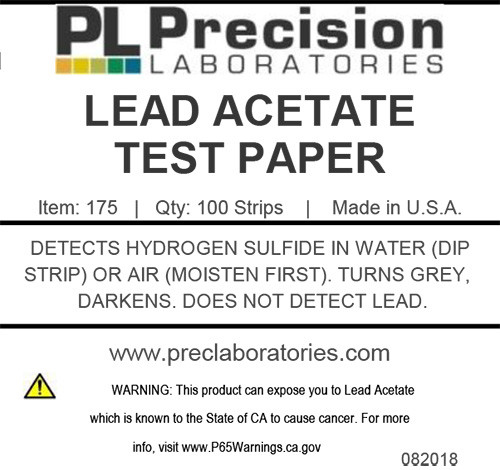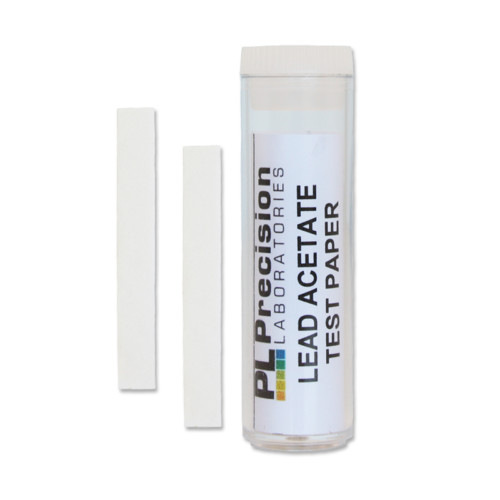-
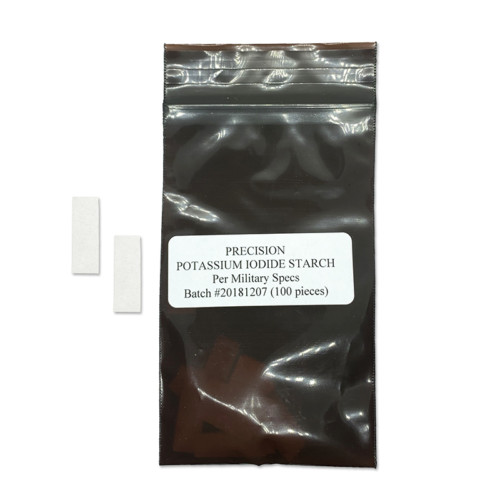 Military Potassium Iodide Starch Test Paper should be used in conjunction with an Abel Test Apparatus to monitor the stability of nitrocellulose propellants by measuring the time interval needed to evolve nitrogen oxide gases from a heated sample. As nitrocellulose propellants degrade, they generate nitrogen oxide. This nitrogen oxide is detected by a color change of the Military Potassium Iodide Test Paper. Military Potassium Iodide Starch Test Paper employs the Potassium Iodide Starch indicator method, and it is produced under strictly controlled conditions. The test strips change to a blue/purple (Starch Iodide complex) color when the decomposition products of nitrocellulose are present. There is no color chart included. The Military Potassium Iodide Starch Test is one of a group of test methods, along with the Military Methyl Violet Test used to assess the stability of nitrocellulose propellants.
Military Potassium Iodide Starch Test Paper should be used in conjunction with an Abel Test Apparatus to monitor the stability of nitrocellulose propellants by measuring the time interval needed to evolve nitrogen oxide gases from a heated sample. As nitrocellulose propellants degrade, they generate nitrogen oxide. This nitrogen oxide is detected by a color change of the Military Potassium Iodide Test Paper. Military Potassium Iodide Starch Test Paper employs the Potassium Iodide Starch indicator method, and it is produced under strictly controlled conditions. The test strips change to a blue/purple (Starch Iodide complex) color when the decomposition products of nitrocellulose are present. There is no color chart included. The Military Potassium Iodide Starch Test is one of a group of test methods, along with the Military Methyl Violet Test used to assess the stability of nitrocellulose propellants. -
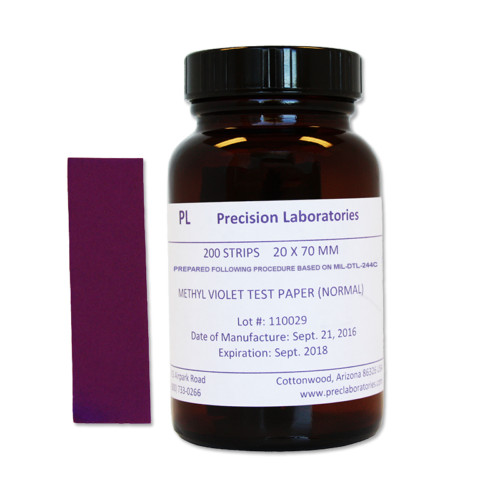 Military Methyl Violet test paper should be used in conjunction with a Methyl Violet Test Apparatus to monitor the stability of single-base and double-base nitrocellulose propellants by measuring the time interval needed to evolve nitrogen oxide gases from a heated sample. As nitrocellulose propellants degrade, they generate nitrogen oxide. This nitrogen oxide is detected by a color change of the Military Methyl Violet test paper. Military Methyl Violet test paper employs pararosaniline acetate and methyl violet indicators, and it is produced under strictly controlled conditions, based on US Navy Specifications (MIL-DTL-244C). The test strips change from a dark violet color to salmon pink when the decomposition products of nitrocellulose are present. There is no color chart for this test paper. Disclaimer: The test papers sold by Precision Laboratories have not been certified (as defined MIL-DTL-244C Amendment 1). When applicable, certification should be performed by a qualified lab.
Military Methyl Violet test paper should be used in conjunction with a Methyl Violet Test Apparatus to monitor the stability of single-base and double-base nitrocellulose propellants by measuring the time interval needed to evolve nitrogen oxide gases from a heated sample. As nitrocellulose propellants degrade, they generate nitrogen oxide. This nitrogen oxide is detected by a color change of the Military Methyl Violet test paper. Military Methyl Violet test paper employs pararosaniline acetate and methyl violet indicators, and it is produced under strictly controlled conditions, based on US Navy Specifications (MIL-DTL-244C). The test strips change from a dark violet color to salmon pink when the decomposition products of nitrocellulose are present. There is no color chart for this test paper. Disclaimer: The test papers sold by Precision Laboratories have not been certified (as defined MIL-DTL-244C Amendment 1). When applicable, certification should be performed by a qualified lab. -
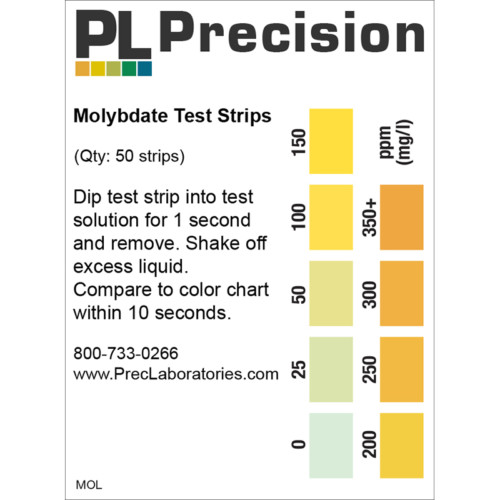
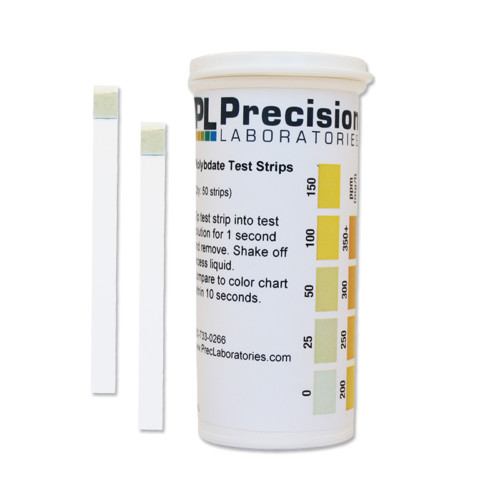 The Molybdate test strip detects molybdate (MoO4-2) levels from 0-350ppm in increments of 0-25-50-100-150-200-250-300-350ppm. Molybdate is commonly used as a corrosion inhibitor in the water treatment industry. Molybdate is effective in chilled or hot water systems over a wide pH range and is not normally affected by the use of biocides, such as chlorine. When used alone, molybdate levels of 300 ppm or more are needed to effectively inhibit corrosion. This can be expensive, and therefore most molybdate-based inhibitors include other ingredients that enhance the overall inhibition properties and reduce the amount of molybdate needed. This test strip can provide an economical means to monitor ppm levels. Consult with the manufacturer of the treatment chemical being used for details on the concentration of molybdate to be maintained.
The Molybdate test strip detects molybdate (MoO4-2) levels from 0-350ppm in increments of 0-25-50-100-150-200-250-300-350ppm. Molybdate is commonly used as a corrosion inhibitor in the water treatment industry. Molybdate is effective in chilled or hot water systems over a wide pH range and is not normally affected by the use of biocides, such as chlorine. When used alone, molybdate levels of 300 ppm or more are needed to effectively inhibit corrosion. This can be expensive, and therefore most molybdate-based inhibitors include other ingredients that enhance the overall inhibition properties and reduce the amount of molybdate needed. This test strip can provide an economical means to monitor ppm levels. Consult with the manufacturer of the treatment chemical being used for details on the concentration of molybdate to be maintained. -
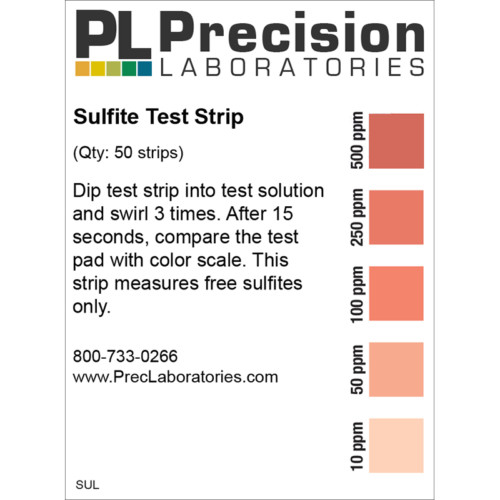
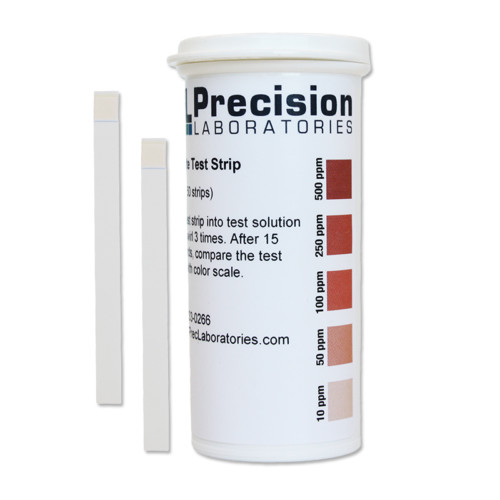 The Sulfite Test Strip is used to detect Sulfite ions in water-based solutions, measuring in increments of 10, 50, 100, 250, and 500ppm. The Sulfite test strip will detect free sulfite. Detection of combined or total (free + combined) sulfite requires additional sample prep. Various types of sulfites can be tested with this strip: sulfite, bisulfite, and metabisulfite. Our original color chart was developed to measure sulfite ions in ppm (from sodium sulfite standards), however, we have checked standards and found that bisulfite and metabisulfite also match the same color chart.
The Sulfite Test Strip is used to detect Sulfite ions in water-based solutions, measuring in increments of 10, 50, 100, 250, and 500ppm. The Sulfite test strip will detect free sulfite. Detection of combined or total (free + combined) sulfite requires additional sample prep. Various types of sulfites can be tested with this strip: sulfite, bisulfite, and metabisulfite. Our original color chart was developed to measure sulfite ions in ppm (from sodium sulfite standards), however, we have checked standards and found that bisulfite and metabisulfite also match the same color chart. -
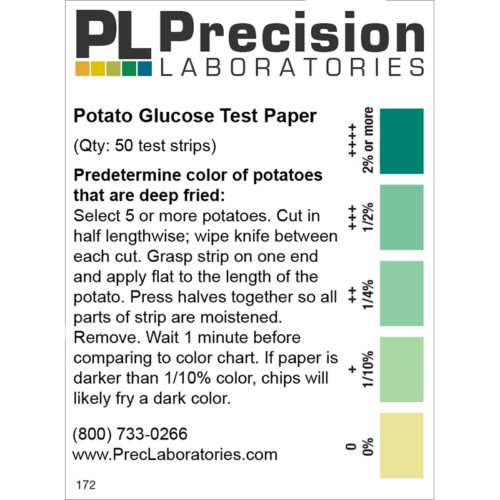
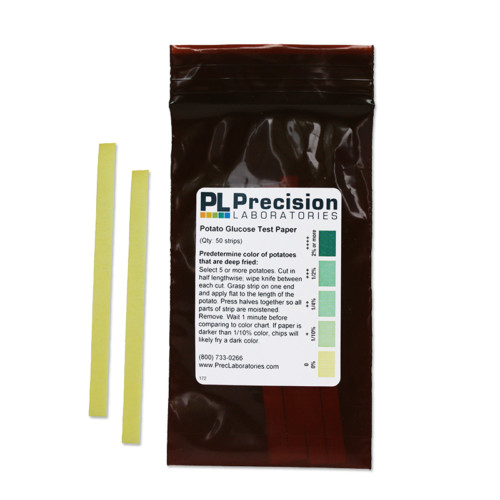 The Potato test paper is designed to detect sugar levels in potatoes. The amount of free glucose is proportional to the darkness of the potato, thus the strip can be used to determine color prior to deep frying. Potato test paper can also be used to demonstrate osmosis across a membrane, similar to the way the small intestine works, by showing that glucose, but not starch, crosses the barrier. The color chart indicates concentration levels in mg/dL but this can be converted to mmol/L by multiplying by 0.055. eg. 100mg/dL is equal to 5.5mmol/L. Potato test paper is not intended for medical diagnosis. Should you decide to test your urine and you get any positive result you should report it to your physician and test your blood sugar levels.
The Potato test paper is designed to detect sugar levels in potatoes. The amount of free glucose is proportional to the darkness of the potato, thus the strip can be used to determine color prior to deep frying. Potato test paper can also be used to demonstrate osmosis across a membrane, similar to the way the small intestine works, by showing that glucose, but not starch, crosses the barrier. The color chart indicates concentration levels in mg/dL but this can be converted to mmol/L by multiplying by 0.055. eg. 100mg/dL is equal to 5.5mmol/L. Potato test paper is not intended for medical diagnosis. Should you decide to test your urine and you get any positive result you should report it to your physician and test your blood sugar levels. -
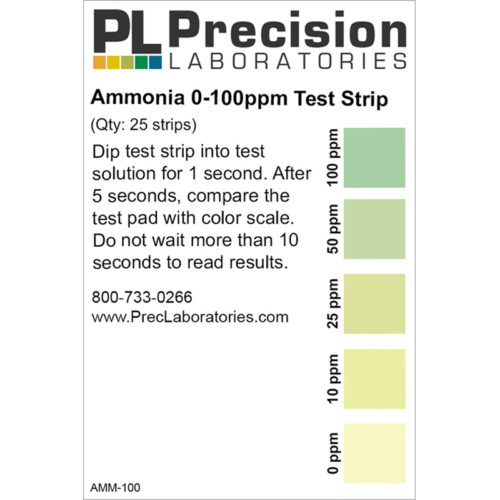
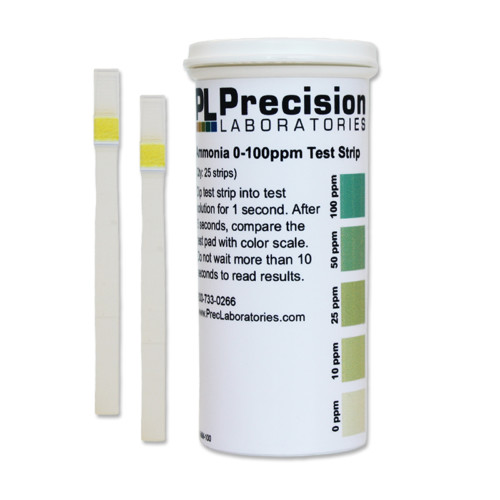 This test strip detects ammonia in increments of 0, 10, 25, 50, and 100ppm. The Low Level Ammonia test strip is designed to work for the detection of ammonia (NH3/NH4+) in water. The strip is composed of two filter pads. The first filter pad acts as an absorbent and takes up the water sample. The first pad has been treated with alkaline materials. This alkaline environment converts any ammonia to the gaseous state. The second filter pad is an hydrophobic material that has been treated in such a manner that only the gaseous ammonia is absorbed by the second filter pad. The second filter pad contains an indicator(s) capable of detecting the gaseous ammonia through a change in the pH of the filter pad.
This test strip detects ammonia in increments of 0, 10, 25, 50, and 100ppm. The Low Level Ammonia test strip is designed to work for the detection of ammonia (NH3/NH4+) in water. The strip is composed of two filter pads. The first filter pad acts as an absorbent and takes up the water sample. The first pad has been treated with alkaline materials. This alkaline environment converts any ammonia to the gaseous state. The second filter pad is an hydrophobic material that has been treated in such a manner that only the gaseous ammonia is absorbed by the second filter pad. The second filter pad contains an indicator(s) capable of detecting the gaseous ammonia through a change in the pH of the filter pad.


